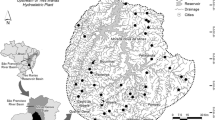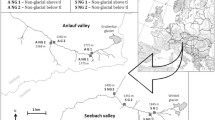Abstract
Is there a relationship between the abundance of organisms and particular biological attributes? To assess this old, yet still acutely debated key question of ecology, we have used large databases on 312 stream macroinvertebrate genera (from 27 orders) that describe (1) invertebrate abundance at 527 least human-impacted European stream sites, (2) 11 biological traits (size, life-history, food, among others) described in 61 biological trait categories (BTCs; e.g. small, intermediate or large size) and (3) 14 attributes indicating specialization (AISs; e.g. species richness, size and food diversity). We applied interactive procedures to obtain models (for BTCs, AISs and a mixture of both descriptions) explaining as much as possible of the abundance variability of the genera with the lowest number of significant and ecologically meaningful attributes and assessed the predictive power of these models (in crosswise validations) by comparing predicted and observed abundances. Mean European invertebrate abundance increased with BTC affinities favouring viability in stream systems (e.g. attachment to the stream bottom to resist the flow, aquatic passive dispersal with the flow, exploitation of abundant food sources) and decreased with BTC affinities disfavouring this viability (e.g. drag force increase associated with larger body size, flow exposure associated with aerial respiration). Abundance consistently decreased with specialization of the genera (e.g. low species richness, oddity of their overall BTC profile from an “average” European genus). The model including a mixture of a few BTCs and AISs had the greatest predictive power: it predicted 35% of the observed abundance (ln-transformed) variability of the genera; these predictions were marginally affected by taxonomy (using orders as categorical variables). We conclude that a better appreciation of the influence of the examined taxonomic diversity, number and type of biological attributes, environmental system and spatial scale could enable abundance predictions using different sets of biological attributes for different taxonomic groups and systems.

Similar content being viewed by others
References
Allan JD (1995) Stream ecology. Chapman & Hall, London
Bêche LA, Resh VH (2007) Biological traits of benthic macroinvertebrates in California Mediterranean-climate streams: long-term annual variability and trait diversity patterns. Fundam Appl Limnol 169:1–23
Bêche LA, McElravy EP, Resh VH (2006) Long-term seasonal variation in the biological traits of benthic-macroinvertebrates in two Mediterranean-climate streams in California, U.S.A. Freshw Biol 51:56–75
Bilton D, Freeland JR, Okamura B (2001) Dispersal in freshwater invertebrates. Annu Rev Ecol Syst 32:159–181
Bonada N, Prat N, Resh VH, Statzner B (2006) Developments in aquatic insect biomonitoring: a comparative analysis of recent approaches. Annu Rev Entomol 51:495–523
Bonada N, Dolédec S, Statzner B (2007) Taxonomic and biological trait differences of stream macroinvertebrate communities between Mediterranean and temperate regions: implications for future climatic scenarios. Glob Chang Biol 13:1658–1671
Borcard D, Legendre P, Drapeau P (1992) Partialling out the spatial component of ecological variation. Ecology 73:1045–1055
Brändle M, Stadler J, Klotz S, Brandl R (2003) Distributional range size of weedy plant species is correlated to germination patterns. Ecology 84:136–144
Burnham KP, Anderson DR (2004) Multimodel inference: understanding AIC and BIC in model selection. Workshop on model selection, Amsterdam. Available at: http://www2.fmg.uva.nl/modelselection/presentations/AWMS2004-Burnham-paper.pdf
Davies KF, Margules CR, Lawrence JF (2000) Which traits of species predict population declines in experimental forest fragments? Ecology 81:1450–1461
Devin S, Bollache L, Noel P-Y, Beisel J-N (2005) Patterns of biological invasions in French freshwater systems by non-indigenous macroinvertebrates. Hydrobiologia 551:137–146
Dolédec S, Olivier J-M, Statzner B (2000) Accurate description of the abundance of taxa and their biological traits in stream invertebrate communities: effects of taxonomic and spatial resolution. Arch Hydrobiol 148:25–43
Ferguson SH, Higdon JW (2006) How seals divide up the world: environment, life history, and conservation. Oecologia 150:318–329
Gaston KJ (1994) Rarity. Chapman & Hall, London
Golden DM, Crist TO (1999) Experimental effects of habitat fragmentation on old-field canopy insects: community, guild and species responses. Oecologia 118:371–380
Gordon ND, McMahon TA, Finlayson BL (1992) Stream hydrology. Wiley, Chichester
Harcourt AH, Coppeto SA, Parks SA (2002) Rarity, specialization and extinction in primates. J Biogeogr 29:445–456
Hausdorf B (2007) The interspecific relationship between abundance and body size in central European land snail assemblages. Basic Appl Ecol 8:125–134
Henle K, Davies KF, Kleyer M, Margules C, Settele J (2004) Predictors of species sensitivity to fragmentation. Biodivers Conserv 13:207–251
Illies J (ed) (1978) Limnofauna Europaea, 2nd edn. Fischer, Stuttgart
Isaac NJB, Mallet J, Mace GM (2004) Taxonomic inflation: its influence on macroecology and conservation. Trends Ecol Evol 19:464–469
Johnson JB, Omland KS (2004) Model selection in ecology and evolution. Trends Ecol Evol 19:101–108
Jones MJ, Fielding A, Sullivan M (2006) Analysing extinction risk in parrots using decision trees. Biodivers Conserv 15:1993–2007
Kelly CK, Woodward FI (1996) Ecological correlates of plant range size: taxonomies and phylogenies in the study of plant commonness and rarity in Great Britain. Phil Trans R Soc Lond B Biol Sci 351:1261–1269
Krasnov BR, Shenbrot GI, Khokhlova IS, Poulin R (2006) Is abundance a species attribute? An example with haematophagous ectoparasites. Oecologia 150:132–140
Lloyd KM, Wilson JB, Lee WG (2003) Correlates of geographic range size in New Zealand Chionochloa (Poaceae) species. J Biogeogr 30:1751–1761
Mac Nally R (2000) Regression and model-building in conservation biology, biogeography and ecology: the distinction between—and reconciliation of—“predictive” and “explanatory” models. Biodivers Conserv 9:655–671
Marks CO, Muller-Landau HC (2007) Comment on “From plant traits to plant communities: a statistical mechanistic approach to biodiversity”. Science 316:1425
Mathews S, Bonser SP (2005) Life histories, ecological tolerance limits, and the evolution of geographic range size in Eucalyptus (Myrtaceae). Aust J Bot 53:501–508
Maxwell TAD, Jennings S (2006) Predicting abundance-body size relationships in functional and taxonomic subsets of food webs. Oecologia 150:282–290
McGill BJ (2006) A renaissance in the study of abundance. Science 314:770–772
Murray BR, Hose GC (2005) Life-history and ecological correlates of decline and extinction in the endemic Australian frog fauna. Aust Ecol 30:546–571
Murray BR, Thrall PH, Gill AM, Nicotra AB (2002) How plant life-history and ecological traits relate to species rarity and commonness at varying spatial scales. Aust Ecol 27:291–310
Peters RH (1983) The ecological implications of body size. Cambridge University Press, Cambridge
Poff NL, Olden JD, Vieira NKM, Finn DS, Simmons MP, Kondratieff BC (2006) Functional trait niches of North American lotic insects: traits-based ecological applications in light of phylogenetic relationships. J N Am Benthol Soc 25:730–755
Resh VH, Bêche LA, McElravy EP (2005) How common are rare taxa in long-term benthic macroinvertebrate surveys. J N Am Benthol Soc 24:976–989
Roxburgh SH, Mokany K (2007) Comment on “From plant traits to plant communities: a statistical mechanistic approach to biodiversity”. Science 316:1425
Schuhmacher H (1970) Untersuchungen zur Taxonomie, Biologie und Ökologie einiger Köcherfliegenarten der Gattung Hydropsyche Pict. (Insecta, Trichoptera). Int Rev Ges Hydrobiol 55:511–557
Shahabuddin G, Ponte CA (2005) Frugivorous butterfly species in tropical forest fragments: correlates of vulnerability to extinction. Biodivers Conserv 14:1137–1152
Shipley B, Vile D, Garnier E (2006) From plant traits to plant communities: a statistical mechanistic approach to biodiversity. Science 314:812–814
Shipley B, Vile D, Garnier E (2007) Response to comments on “From plant traits to plant communities: a statistical mechanistic approach to biodiversity”. Science 316:1425
Spellerberg IF (1991) Monitoring ecological change. Cambridge Univ Press, Cambridge
Statzner B, Resh VH (1993) Multiple-site and -year analyses of stream insect emergence: a test of ecological theory. Oecologia 96:65–79
Statzner B, Gore JA, Resh VH (1988) Hydraulic stream ecology: observed patterns and potential applications. J N Am Benthol Soc 7:307–360
Statzner B, Bis B, Dolédec S, Usseglio-Polatera P (2001a) Perspectives for biomonitoring at large spatial scales: a unified measure for the functional composition of invertebrate communities in European running waters. Basic Appl Ecol 2:73–85
Statzner B, Hildrew AG, Resh VH (2001b) Species traits and environmental constraints: entomological research and the history of ecological theory. Annu Rev Entomol 46:291–316
Statzner B, Dolédec S, Hugueny B (2004) Biological trait composition of European stream invertebrate communities: assessing the effects of various trait filter types. Ecography 27:470–488
Statzner B, Bady P, Dolédec S, Schöll F (2005) Invertebrate traits for the biomonitoring of large European rivers: an initial assessment of trait patterns in least impacted river reaches. Freshw Biol 50:2136–2161
Statzner B, Bonada N, Dolédec S (2007) Conservation of taxonomic and biological trait diversity of European stream macroinvertebrate communities: a case for a collective public database. Biodivers Conserv 16:3609–3632
Symonds MRE, Christidis L, Johnson CN (2006) Latitudinal gradients in abundance, and the causes of rarity in the tropics: a test using Australian honeyeaters (Aves: Meliphagidae). Oecologia 149:406–417
Tachet H, Richoux P, Bournaud M, Usseglio-Polatera P (2002) Invertébrés d’eau douce, 2nd corrected impr. CNRS éditions, Paris
Tales E, Keith P, Oberdorff T (2004) Density-range size relationships in French riverine fishes. Oecologia 138:360–370
Tscharntke T, Brandl R (2004) Plant-insect interactions in fragmented landscapes. Annu Rev Entomol 49:405–430
Vogel S (1994) Live in moving fluids, 2nd edn. Princeton University Press, Princeton
Ward JV, Tockner K (2001) Biodiversity: towards a unifying theme for river ecology. Freshw Biol 46:807–819
Woodward G, Ebenman B, Emmerson M, Montoya JM, Olesen JM, Valido A, Warren PH (2005) Body size in ecological networks. Trends Ecol Evol 20:402–409
Acknowledgments
We thank all researchers and editors who published results in a format such that we could use them for our database and the many colleagues that provided personal information to fill data gaps (all mentioned in previous papers using the data for other purposes). We also acknowledge comments on this manuscript by Leah Bêche, Bernard Hugueny, Sven Bacher and three anonymous referees.
Author information
Authors and Affiliations
Corresponding author
Additional information
Communicated by Sven Bacher.
Appendix
Appendix
Biological traits and their categories in the database (see Tachet et al. 2002, for detailed explanations of categories):
-
1.
Maximum size (mm): ≤2.5; >2.5–5; >5–10; >10–20; >20–40; >40–80; >80.
-
2.
Life cycle duration (year): ≤1; >1.
-
3.
Potential number of reproduction cycles per year: <1; 1; >1.
-
4.
Aquatic stages: egg; larva; nymph; imago.
-
5.
Reproduction: ovoviviparity; isolated eggs, free (not fixed to a substrate); isolated eggs, cemented; clutches, cemented or fixed; clutches, free; eggs or clutches in vegetation (endophytic); clutches, terrestrial; asexual reproduction.
-
6.
Dispersal: aquatic passive; aquatic active; aerial passive; aerial active.
-
7.
Mechanisms for resistance against unfavourable conditions: eggs, statoblasts, gemmules; cocoons; using refuges (e.g. small crevices) to resist desiccation during droughts; diapause or dormancy; none.
-
8.
Respiration technique: tegument; gill; plastron; aerial (e.g. spiracle).
-
9.
Locomotion and substrate relation: flier; surface swimmer; swimmer; crawler; burrower (epibenthic); interstitial (endobenthic); temporarily attached; almost permanently attached.
-
10.
Food: fine sediment and microrganisms; detritus <1 mm; plant detritus ≥1 mm; living microphytes; living macrophytes; dead animals ≥1 mm; living microinvertebrates; living macroinvertebrates; vertebrates.
-
11.
Feeding habits: deposit feeder; shredder; scraper; filter-feeder; piercer (plants or animals); predator (carver/engulfer/swallower); parasite, parasitoid.
Rights and permissions
About this article
Cite this article
Statzner, B., Bonada, N. & Dolédec, S. Predicting the abundance of European stream macroinvertebrates using biological attributes. Oecologia 156, 65–73 (2008). https://doi.org/10.1007/s00442-008-0972-7
Received:
Accepted:
Published:
Issue Date:
DOI: https://doi.org/10.1007/s00442-008-0972-7




